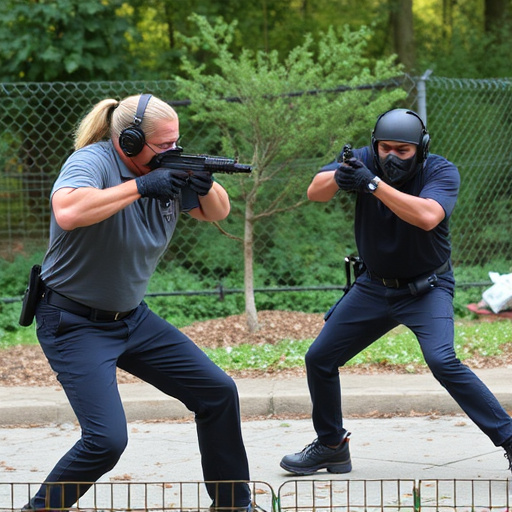Voltage penetration through clothing varies based on material conductivity and thickness, affecting the effectiveness of stun guns. Thin fabrics allow for deeper penetration while thicker materials hinder current reach. Factors like material type, construction, moisture content, and age/wear influence clothing's resistance to electricity and protection against stun guns. Stun guns, with varying voltage and current outputs, have differing efficacies on individuals; advanced models can penetrate thick fabrics but impact varies. Understanding these dynamics is crucial for personal safety, as pairing stun guns with self-defense training acknowledges their potential limitations through fabric interference.
In today’s world, understanding voltage penetration through thick clothing is crucial, especially in light of growing concerns about stun gun effectiveness. This comprehensive article delves into how voltage behaves when encountering diverse fabrics, exploring factors that influence clothing’s resistance to electricity. We dissect the impact on stun gun efficacy, highlighting variations based on individuals’ body types and garment choices. Furthermore, safety considerations and mitigation strategies are discussed, providing insights into mitigating risks associated with electrical penetration.
- Understanding Voltage Penetration: How It Works
- Factors Affecting Clothing's Resistance to Electricity
- Stun Gun Effectiveness: A Comprehensive Look
- Safety Considerations: Risks and Mitigation Strategies
Understanding Voltage Penetration: How It Works

Voltage penetration through thick clothing is a complex phenomenon that varies based on several factors, including the material’s electrical conductivity and thickness. When considering the effectiveness of stun guns, understanding how voltage permeates different fabrics is crucial. Stun guns emit an electric charge designed to disrupt muscle control in a target, rendering them temporarily incapacitated. However, the penetration depth of this voltage can differ significantly depending on the person’s body composition and the type of clothing they’re wearing.
For instance, while thin materials like cotton or silk allow for better conductivity and thus deeper penetration, thicker fabrics like denim or leather can act as barriers. This isn’t to say that stun guns are ineffective against such materials; instead, the current may not reach deep enough to achieve the desired stun effect on larger individuals or those with higher muscle mass. Conversely, proper body positioning and understanding how voltage interacts with clothing can enhance a stun gun’s effectiveness for anyone, regardless of their physical attributes.
Factors Affecting Clothing's Resistance to Electricity

The resistance of clothing to electricity, or its ability to protect against the stun gun’s effects, varies based on several factors. One key consideration is the material and construction of the fabric. Natural fibers like cotton and wool are generally better conductors of electricity than synthetic materials such as polyester or nylon. The thickness and density of the garment also play a significant role; heavier fabrics with tightly woven threads offer more protection due to their increased resistance to electrical current flow.
Furthermore, moisture content can drastically affect clothing’s conductivity. Wet or damp clothes conduct electricity more efficiently than dry ones, which can enhance the stun gun’s impact. Age and wear also matter; worn-out or aged clothing might have weakened fibers and loose threads, making it less effective at insulating against electrical shock. Understanding these factors is crucial in assessing the potential protection offered by different types of clothing against a stun gun’s effectiveness on various individuals.
Stun Gun Effectiveness: A Comprehensive Look

Stun guns, often touted as non-lethal weapons, rely on high voltage and low current to disrupt muscular control, temporarily rendering a target immobile. However, their effectiveness can vary significantly depending on several factors, including the stun gun’s power output, the distance between the device and the target, and the target’s physical attributes like body type, clothing, and overall health.
When it comes to thick clothing, the story becomes more complex. While standard stun guns may struggle to penetrate materials like denim or leather jackets, advanced models with higher voltage and specialized probes can still deliver a shock. The impact on different individuals will depend on the thickness and conductivity of the fabric they’re wearing. For instance, a thin cotton shirt might not impede a strong stun gun’s current, while a thick woolen coat could significantly reduce its effectiveness. Thus, understanding both the capabilities of modern stun guns and the varying levels of protection offered by clothing is crucial for assessing their overall effectiveness on different people.
Safety Considerations: Risks and Mitigation Strategies

When considering the effectiveness of stun guns, it’s crucial to understand the potential risks and safety considerations, especially when thinking about how voltage can penetrate thick clothing. Stun guns, or electronic control devices (ECDs), emit an electric current that disrupts muscle control in a targeted person, temporarily incapacitating them. However, this energy transfer is not uniform; its impact varies based on several factors, including the thickness and material of the fabric. Heavier garments, like bulletproof vests or thick coats, can significantly reduce the stun gun’s effectiveness.
Mitigating these risks involves understanding that while stun guns may still deliver a shock through thicker fabrics, their success rate decreases considerably. For personal safety, it’s essential to pair stun guns with other protective measures, such as self-defense training and awareness of surroundings. Additionally, knowing the range limitations of your device is vital; devices might not be effective beyond close range due to potential fabric interference.
Understanding voltage penetration through thick clothing is crucial, especially when considering its impact on stun gun effectiveness. As we’ve explored, factors like material composition and thickness significantly alter resistance, affecting how much current can pass through. When it comes to stun guns, this knowledge highlights the importance of targeted application for optimal effectiveness on different individuals. By accounting for these variables, users can ensure safer and more reliable outcomes, reinforcing safety considerations crucial in any electrical interaction.
